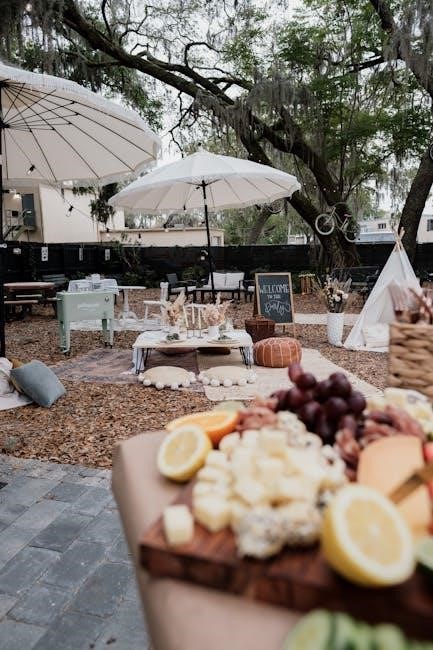
A 10×30 canopy tent is a versatile and spacious shelter solution‚ ideal for outdoor events‚ parties‚ and gatherings. Made with durable materials‚ these tents offer adjustable height settings‚ removable sidewalls‚ and weather-resistant features‚ ensuring long-lasting performance. Perfect for weddings‚ commercial uses‚ or social gatherings‚ this size provides ample space for guests and activities‚ making it a popular choice for creating shaded areas in various settings.
Overview of 10×30 Canopy Tents
A 10×30 canopy tent is a large‚ portable shelter designed for outdoor events‚ offering ample space for gatherings‚ parties‚ or commercial activities. Constructed with durable‚ weather-resistant materials‚ these tents provide reliable protection from sun‚ rain‚ and wind. Their sturdy frames and adjustable features ensure stability and versatility‚ making them ideal for weddings‚ festivals‚ and social events. Available in various styles‚ they suit different needs‚ ensuring a safe and stylish space for any occasion.
Popular Uses for 10×30 Canopy Tents
10×30 canopy tents are widely used for outdoor events like weddings‚ parties‚ festivals‚ and corporate gatherings. They provide ample space for hosting large groups‚ making them ideal for social celebrations and commercial activities. These tents are also commonly employed for fairs‚ sports events‚ and as temporary shelters for markets or exhibitions. Their versatility and durability make them a practical choice for various outdoor needs‚ ensuring a reliable and stylish space for both small and large-scale events.
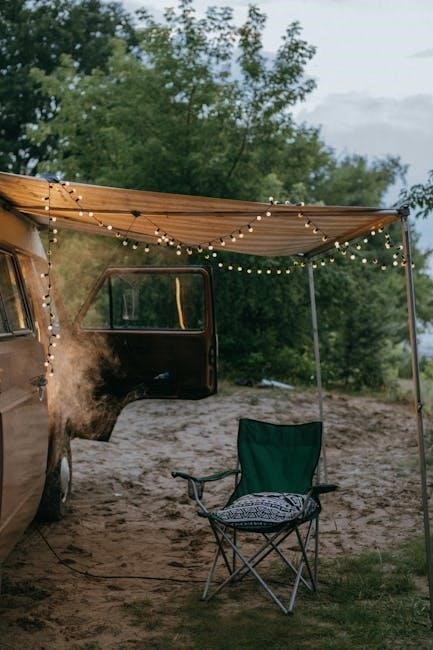
Key Features of 10×30 Canopy Party Tents
10×30 canopy tents feature durable‚ weather-resistant materials‚ adjustable height settings‚ and removable sidewalls. They also include heavy-duty frames and sturdy construction‚ ensuring stability and reliability for outdoor events.
Durable and Weather-Resistant Materials
10×30 canopy tents are crafted with high-quality‚ weather-resistant materials‚ such as waterproof polyethylene and UPF 50 UV-protected fabric‚ ensuring durability and longevity. The robust frames are designed to withstand harsh weather conditions‚ including heavy rain and strong winds. These materials provide excellent protection from the elements‚ making them ideal for outdoor events and ensuring a safe and stable shelter for years to come.
Adjustable Height Settings
The 10×30 canopy tent features adjustable height settings‚ allowing users to customize the tent’s height based on specific needs. This versatility ensures the tent can accommodate various events‚ from low-clearance gatherings to high-ceiling requirements. The height adjustments are typically made using leg pins or locking mechanisms‚ providing stability and adaptability. This feature enhances the tent’s functionality‚ making it suitable for diverse outdoor activities and setups.
Removable and Customizable Sidewalls
The 10×30 canopy tent comes with removable and customizable sidewalls‚ offering flexibility for various events. These sidewalls can be easily attached or detached based on weather conditions or aesthetic preferences. Made from durable materials‚ they provide protection from wind and rain while allowing for optional windows or decorative elements. This feature ensures the tent can be tailored to suit different occasions‚ enhancing both functionality and visual appeal for weddings‚ parties‚ or commercial events.
Heavy-Duty Frames and Sturdy Construction
The 10×30 canopy tent features a heavy-duty frame made from high-quality materials like steel or aluminum‚ ensuring maximum durability and stability. Its sturdy construction withstands harsh weather conditions‚ including strong winds and rain. Designed for long-lasting performance‚ the frame provides reliable support for the canopy top and sidewalls. This robust build ensures the tent remains secure and stable‚ offering a safe and reliable shelter for outdoor events and gatherings of all sizes.
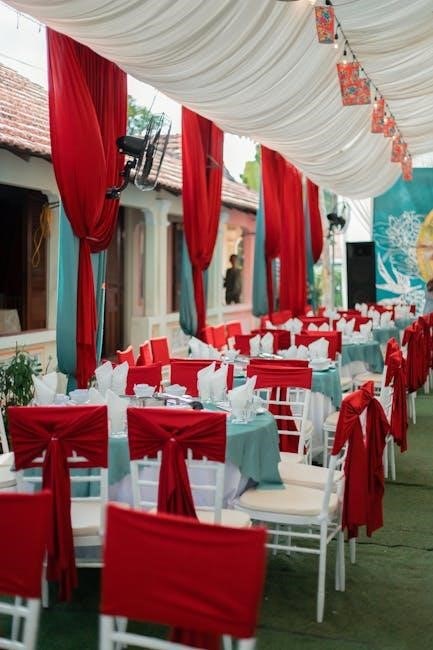
Preparation for Assembly
Before assembling your 10×30 canopy tent‚ ensure the site is level and clear of obstacles. Unpack and organize all components‚ verifying everything is included. Gather necessary tools like wrenches and stakes to streamline the process. Proper preparation ensures a smooth and efficient assembly experience for your event setup.
Choosing the Right Location
Selecting a suitable location for your 10×30 canopy tent is crucial for stability and safety. Ensure the ground is level‚ firm‚ and clear of debris or obstructions. Avoid areas with standing water or where water may pool. Choose a spot with adequate space for the tent’s footprint‚ including room for stakes and guy ropes. Ensure the surface is compatible with the anchoring method‚ whether it’s grass‚ concrete‚ or asphalt‚ to secure the tent properly and prevent damage.
Unpacking and Organizing Components
Begin by carefully unpacking the 10×30 canopy tent from its storage bag. Lay out all components‚ including the frame‚ canopy top‚ sidewalls‚ stakes‚ and guy ropes‚ on a clean‚ dry surface. Check the inventory to ensure all parts are included and undamaged. Organize the pieces by category‚ such as frame sections‚ hardware‚ and accessories‚ to streamline the assembly process and avoid missing items later.
Tools and Equipment Needed
To assemble a 10×30 canopy tent‚ you’ll need essential tools like a screwdriver‚ wrench‚ and hammer for securing stakes. A measuring tape can help ensure proper alignment‚ while a ladder may be necessary for taller adjustments. Additional items like rope‚ weight bags‚ and guy ropes are often included but should be checked. Having these tools ready will streamline the setup process and ensure a secure‚ stable structure for your event or gathering.
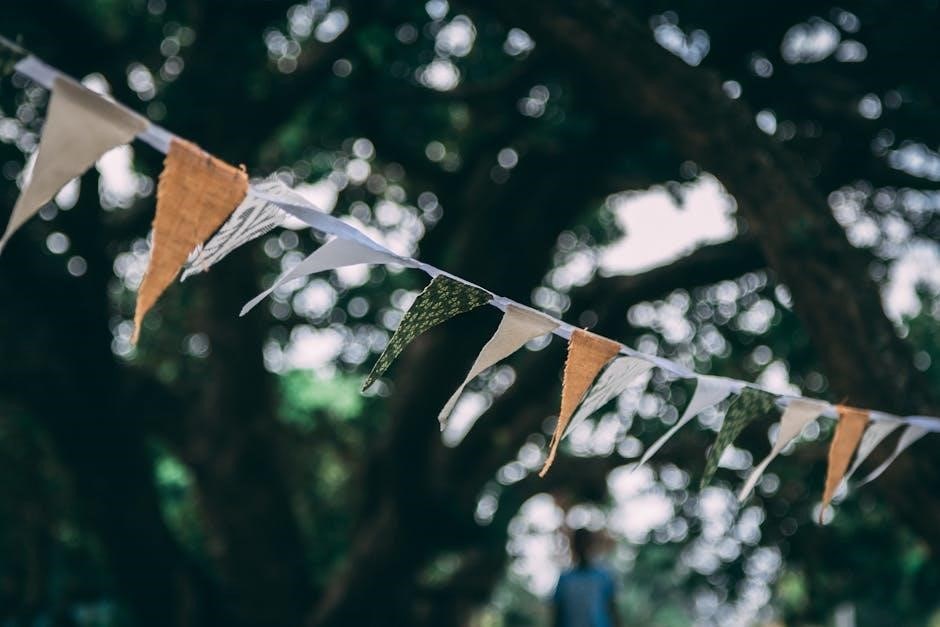
Step-by-Step Assembly Instructions
Begin by unpacking and organizing all components. Start with the frame‚ then attach the canopy top‚ followed by sidewalls. Secure everything tightly and perform final safety checks.
Setting Up the Frame
Start by unpacking and organizing all components‚ ensuring no parts are missing. Lay out the frame pieces on a flat‚ dry surface. Attach the legs to the top frame using snap buttons or bolts‚ following the manufacturer’s instructions. Secure the horizontal beams by snapping or bolting them into place‚ ensuring the frame is square and stable. Use adjustable height settings by moving pins or clips on the legs to achieve the desired height. Finally‚ attach center poles for additional support and ensure all connections are tight. Double-check the frame’s stability and alignment before proceeding to the next step.
Attaching the Canopy Top
Unfold the canopy top and align it with the frame’s center. Begin by securing the canopy to the frame using the provided hook-and-loop straps or Velcro attachments. Tighten each side evenly to avoid wrinkles‚ ensuring a snug fit. Use the center panels to distribute weight evenly and prevent sagging. Finally‚ pull the straps tight and double-check that the canopy is evenly spread and securely fastened to the frame for a stable and weather-tight seal.
Securing the Sidewalls
Attach sidewalls by aligning them with the tent’s frame and using Velcro straps or hooks. Ensure each wall is snug and properly aligned for a secure fit. For added stability‚ stake the sidewalls to the ground‚ especially in windy conditions. Check that all seams and connections are tightly sealed‚ particularly if the sidewalls are waterproof. If windows or openings are present‚ ensure they are correctly aligned and securely fastened. Finally‚ perform a walk-around to tug gently on each sidewall‚ ensuring they are stable and properly attached before final use.
Final Tightening and Safety Checks
Tighten all bolts and straps to ensure the frame is stable and secure. Inspect the canopy and sidewalls for any signs of damage or looseness. Check that all connections are snug and properly aligned. Conduct a final walk-around to verify the tent’s stability‚ ensuring no gaps or weak points remain. Double-check that all safety ropes and stakes are firmly in place to prevent any shifting in the wind; Ensure the tent is ready for safe use by confirming all components are securely fastened and properly aligned.
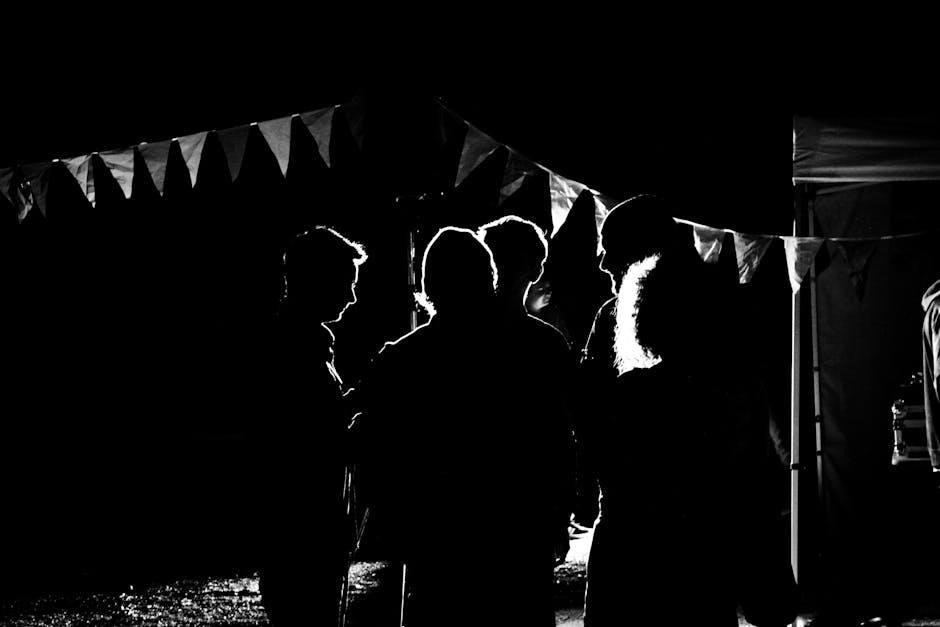
Tips for Securing Your 10×30 Canopy Tent
Use weight bags and stakes to anchor the tent firmly. Install guy ropes for added stability and ensure proper anchoring on various surfaces for maximum safety and durability.
Using Weight Bags and Stakes
Secure your 10×30 canopy tent with weight bags and stakes for stability. Place weight bags on frame corners and drive stakes into the ground at a 45-degree angle. Ensure tight anchoring on grass‚ concrete‚ or asphalt surfaces. Use 8 weight bags and 8 stakes for optimal stability. This method prevents the tent from shifting in windy conditions‚ ensuring a safe and secure setup for your event or gathering.
Installing Guy Ropes for Stability
For added stability‚ install guy ropes on your 10×30 canopy tent. Attach ropes to the top corners of the canopy and secure them to the ground using stakes. Tighten the ropes to ensure the tent is taut and evenly balanced. Use high-quality materials like nylon or polyester for durability. Adjust the ropes as needed to maintain structural integrity‚ especially in windy conditions. This ensures your tent remains stable and secure during events.
Ensuring Proper Anchoring on Different Surfaces
Secure your 10×30 canopy tent on various surfaces by using appropriate anchoring methods. On grass‚ use sturdy stakes driven at an angle. For concrete or asphalt‚ opt for weight bags or specialized anchors. Ensure the tent is tightly fastened to prevent shifting. Regularly inspect the anchors to maintain stability and safety‚ especially in windy or uneven terrain. Proper anchoring ensures your tent remains stable and secure in all conditions.
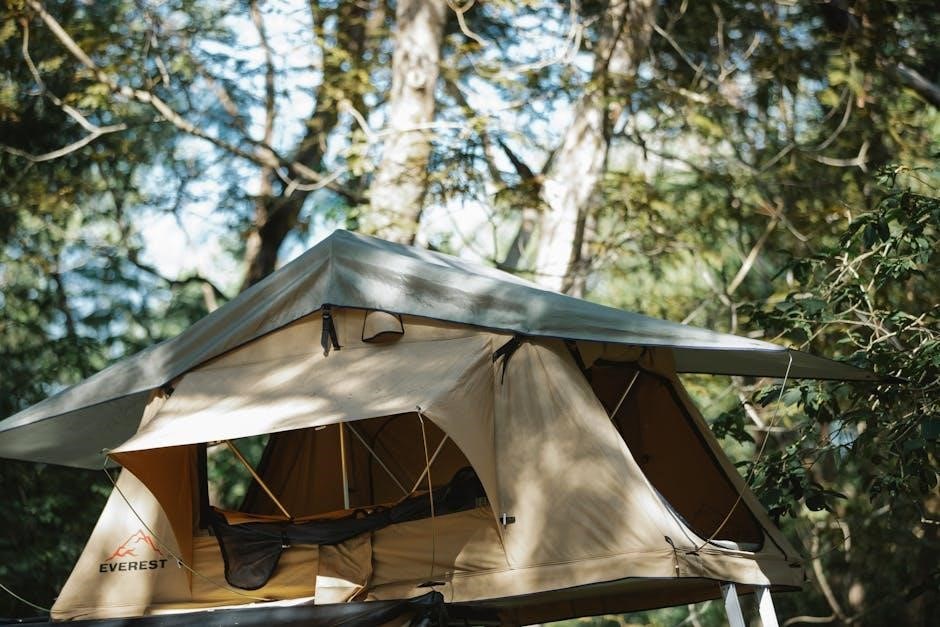
Common Mistakes to Avoid During Setup
Avoid rushing the assembly process and ensure all parts are correctly aligned. Neglecting to tighten all bolts or improperly attaching sidewalls can compromise stability and safety.
Incorrect Frame Alignment
Incorrect frame alignment is a common mistake that can lead to structural instability. Ensure all poles and connectors are properly matched and secured. Misaligned frames may cause uneven surfaces‚ difficulty in attaching the canopy‚ and increased risk of damage from wind or weight. Always double-check the alignment before tightening any bolts. Refer to the instruction manual for guidance‚ and if unsure‚ seek assistance to avoid costly repairs or safety hazards.
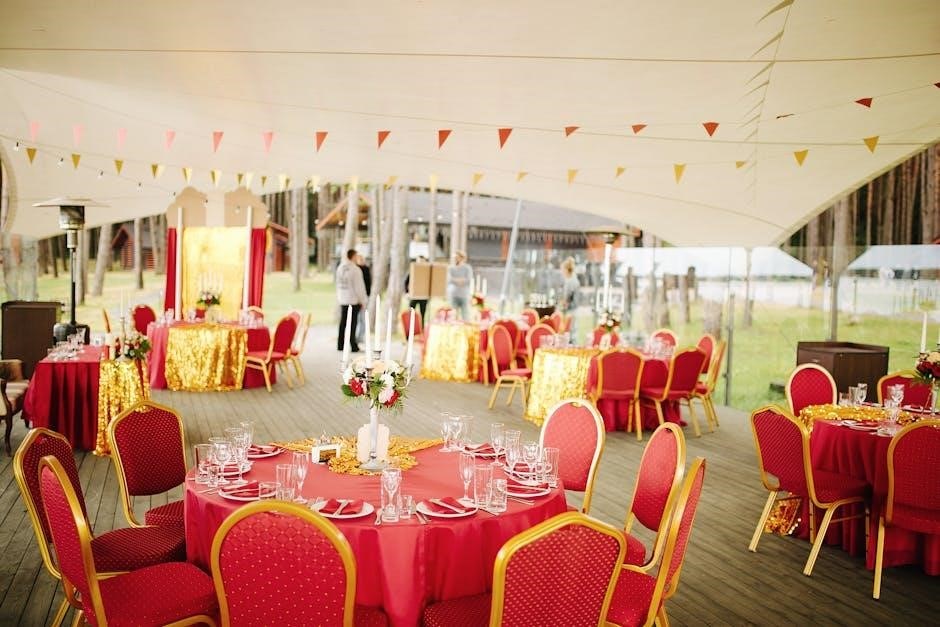
Overlooking Safety Precautions
Neglecting safety measures during setup can lead to accidents and damage. Always ensure the tent is securely anchored to prevent collapse in windy conditions. Check for overhead obstacles and ensure the area is clear of tripping hazards. Never assemble the tent near open flames or sparks‚ and avoid overloading it with excessive weight. Properly follow all safety guidelines in the instruction manual to ensure a safe and enjoyable experience.
Improper Use of Anchoring Tools
Using anchoring tools incorrectly can compromise the stability of your 10×30 canopy tent. Failing to secure stakes properly or not tightening guy ropes can lead to instability‚ especially in windy conditions. Overlooking weight bags or using insufficient anchoring points can result in the tent shifting or collapsing. Always ensure all anchoring tools are used as instructed to maintain structural integrity and prevent potential damage or safety hazards during events.
Using Your 10×30 Canopy Tent
A 10×30 canopy tent is ideal for events‚ parties‚ and gatherings. It provides ample space for guests and activities‚ ensuring durability and weather-resistance. Adjustable height settings and removable sidewalls offer flexibility‚ making it perfect for weddings‚ commercial uses‚ or social gatherings.
Maximizing Space for Events
To maximize space under a 10×30 canopy tent‚ organize seating and tables efficiently‚ utilizing the tent’s length for rows or circular arrangements. Use the adjustable height settings to create a spacious interior and ensure sidewalls are removed for an open layout. This configuration provides ample room for guests and activities‚ making it ideal for weddings‚ parties‚ or commercial events.
Adding Decorations and Lighting
Enhance your event with decorative elements like fairy lights‚ banners‚ or floral arrangements under the 10×30 canopy tent. Use hooks or strings to attach decorations to the frame without damaging it; Incorporate lighting such as LED strips or lanterns to create a warm ambiance. Ensure decorations are secure and balanced to avoid damaging the tent. This adds visual appeal and transforms the space into a memorable setting for weddings‚ parties‚ or gatherings.
Ensuring Ventilation and Shade
The 10×30 canopy tent provides excellent shade with its UPF 50-rated waterproof top‚ protecting guests from harmful UV rays. For ventilation‚ removable sidewalls and optional mesh panels allow airflow‚ preventing heat buildup. Properly securing the tent ensures airflow and shade balance‚ creating a comfortable environment for events. Regularly check and adjust sidewalls to maintain optimal ventilation while providing reliable shade for outdoor gatherings and celebrations.

Safety Precautions and Best Practices
Always monitor weather conditions‚ avoiding strong winds or heavy rain. Regularly inspect the tent for damage‚ and ensure proper anchoring to prevent collapse. Never overload the canopy.
Monitoring Weather Conditions
Always check weather forecasts before setting up your 10×30 canopy tent. Avoid erecting it in strong winds or heavy rain‚ as this can compromise stability. Inspect the tent for damage before use‚ as weakened structures may fail under harsh conditions. Secure the tent properly with stakes and ropes to prevent collapse. Remove loose items that could become projectiles in windy conditions. Have a plan to disassemble the tent if extreme weather arises to ensure safety and prevent damage.
Avoiding Overloading the Canopy
To ensure safety and longevity‚ avoid overloading the 10×30 canopy tent. Excessive weight from decorations‚ equipment‚ or too many people can strain the frame. Distribute weight evenly and avoid hanging heavy objects from the canopy top. Use only recommended accessories and follow the manufacturer’s weight limits. Overloading can lead to structural damage or collapse‚ especially in windy conditions. Always prioritize weight distribution and safety guidelines to maintain stability and durability.
Regular Inspection of the Tent
Regular inspection of the 10×30 canopy tent is essential for maintaining its durability and safety. Check for signs of wear‚ such as torn fabric‚ bent frames‚ or loose connections. Inspect the canopy top for water pooling or leaks‚ and ensure all sidewalls are securely attached. Examine the frame for rust or damage‚ especially after exposure to harsh weather. Addressing issues promptly prevents minor problems from becoming major repairs‚ ensuring the tent remains safe and functional for future events.

Maintenance and Storage
Regularly clean the canopy and frame to prevent dirt buildup. Store the tent in a dry‚ secure location to avoid mold or pest damage. Ensure all parts are properly dried before storage to maintain durability and longevity.
Cleaning the Canopy and Frame
Use mild detergent and water to clean the canopy fabric and frame. Avoid harsh chemicals or abrasive materials that may damage the material. For tough stains‚ gently scrub with a soft-bristled brush. Rinse thoroughly and allow the tent to air dry completely before storage. Regular cleaning prevents mold and mildew buildup‚ ensuring the tent remains in good condition for future use; Always check for any tears or worn areas during cleaning.
Proper Storage Techniques
Store the 10×30 canopy tent in a clean‚ dry‚ and secure location to prevent damage. Use the provided storage bag to protect the tent from dust and pests. Ensure all parts‚ including the frame and sidewalls‚ are properly disassembled and organized. Avoid storing in extreme temperatures or humid environments. Regularly inspect the tent before storage to ensure it is dry and free from damage‚ extending its lifespan and maintaining its quality for future events.
Repairing Damaged Parts
For damaged fabric‚ use waterproof patches or seam sealant to prevent leaks. Replace bent or rusty frame components with manufacturer-approved parts. Tighten loose connections and lubricate moving joints to ensure stability. Inspect and repair any torn or worn-out sidewalls promptly. Regularly check for damage and address issues early to maintain the tent’s structural integrity and longevity. Always refer to the manufacturer’s instructions for specific repair guidelines.
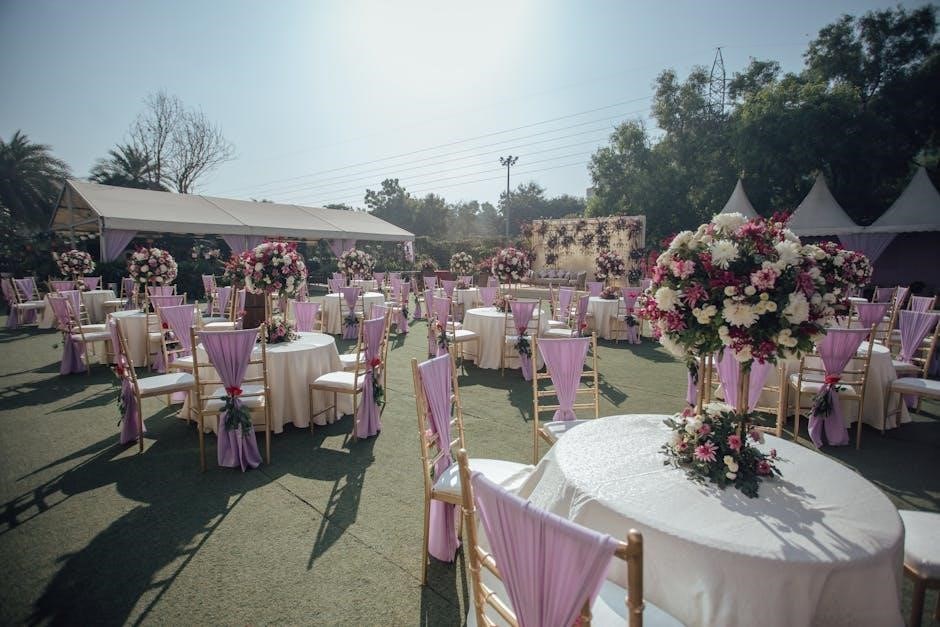
Troubleshooting Common Issues
Address leaks by patching torn fabric. Stabilize wobbly frames by tightening connections. Replace damaged parts promptly to prevent further issues. Regular inspections help identify problems early.
Leaking or Water Pooling
Leaking or water pooling on your canopy tent can occur due to torn fabric‚ improper assembly‚ or clogged drainage. Inspect the canopy for holes or gaps and patch them with a waterproof sealant. Ensure the tent is angled correctly to allow water to run off. Regular cleaning and drying can prevent mold and mildew. If issues persist‚ consider replacing the canopy top or damaged sections for optimal performance.
Frame Stability Problems
Frame stability issues often arise from loose connections‚ uneven ground‚ or improper assembly. Ensure all bolts and joints are tightly secured. Check for level ground and use stakes or weight bags to anchor the tent firmly. If instability persists‚ inspect for bent or damaged frame parts and replace them if necessary. Regularly tightening all hardware can prevent such problems and ensure a sturdy setup for your events.
Damaged or Torn Fabric
Damaged or torn fabric can compromise the tent’s structural integrity and water resistance. Inspect the canopy regularly for signs of wear or tears. For small damages‚ use a repair kit or fabric tape to patch the area. Avoid exposing the tent to harsh weather conditions if the fabric is already compromised. Replace severely damaged fabric promptly to maintain the tent’s functionality and safety during events.
A 10×30 canopy tent offers versatility‚ durability‚ and ease of use‚ making it an essential shelter solution for outdoor events. Invest in a high-quality option for lasting performance and reliability.
Final Tips for Successful Use
For optimal performance‚ always inspect the tent before use and ensure all parts are securely fastened. Regularly clean the canopy and frame to maintain durability. Store the tent in a dry‚ cool place to prevent damage. Consider adding weights or guy ropes for extra stability in windy conditions. Follow the manufacturer’s guidelines for assembly and disassembly to extend the tent’s lifespan. Proper maintenance and storage will ensure your 10×30 canopy tent remains a reliable shelter for years of outdoor events.
Investing in a High-Quality 10×30 Canopy Tent
Purchasing a high-quality 10×30 canopy tent ensures durability and reliability for outdoor events. Look for models with heavy-duty frames‚ waterproof canopies‚ and sturdy construction. Key features include adjustable height settings‚ removable sidewalls‚ and UV protection. Ensure the tent comes with essential accessories like stakes‚ guy ropes‚ and weight bags for stability. A well-made tent provides excellent shade‚ shelter‚ and long-term performance‚ making it a worthwhile investment for frequent use.